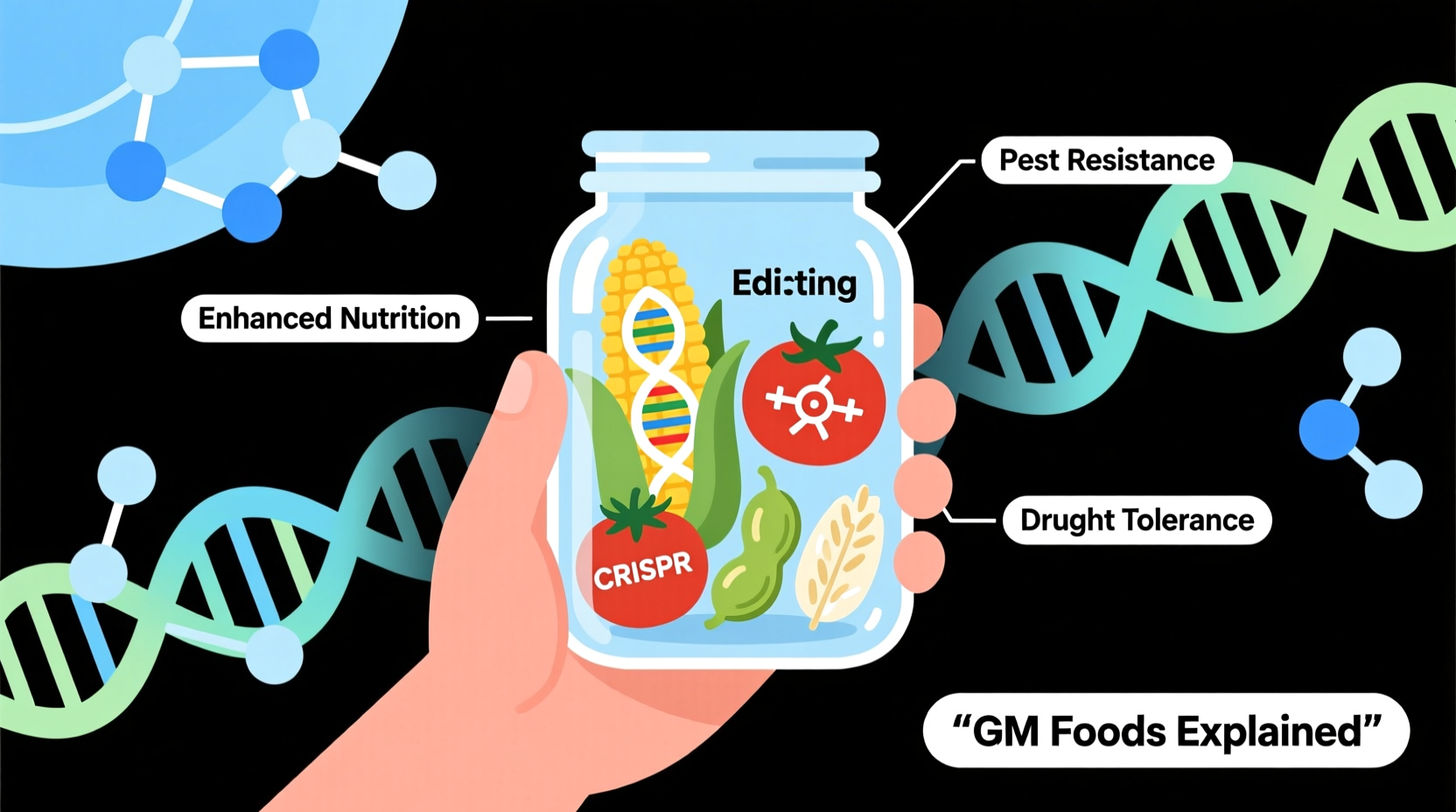Understanding exactly what is in genetically modified foods helps separate scientific reality from common misconceptions. As consumers increasingly question their food sources, knowing the precise components introduced through genetic engineering empowers informed dietary choices without unnecessary fear.
Breaking Down GMO Composition: What's Actually Present
When examining genetically modified organisms in food products, it's essential to distinguish between the tools used in development and what remains in the final food. The genetic modification process introduces specific, well-characterized elements:
- Target trait genes - Specific DNA sequences that produce desired proteins (like Cry proteins for insect resistance)
- Regulatory elements - Promoters (often from cauliflower mosaic virus) that control when the new gene is active
- Terminator sequences - Signal the end of protein production
- Selectable markers (in older GMOs) - Genes helping scientists identify successfully modified plants
During commercial production, developers remove unnecessary elements. The final genetically modified food ingredients contain only the intended trait protein alongside the plant's natural composition - no extraneous DNA fragments or laboratory tools remain in your corn chips or soy milk.
| Component | Present in Final Food? | Purpose | Example |
|---|---|---|---|
| Trait-producing protein | Yes | Provides desired characteristic | Bt protein for insect resistance |
| Promoter sequence | Yes (DNA level) | Controls gene expression | CaMV 35S promoter |
| Gene gun particles | No | Delivery method (removed) | Tungsten/gold nanoparticles |
| Selectable markers | Rarely (newer GMOs) | Identification tool | Antibiotic resistance genes (historical) |

The Genetic Modification Process: From Lab to Plate
Understanding what components are introduced in genetically engineered foods requires examining the development timeline. The process follows strict scientific protocols:
- Gene identification (6-18 months): Scientists identify and isolate the desired trait gene from a compatible organism
- Vector construction (3-6 months): The gene is combined with regulatory elements in a laboratory vector
- Plant transformation (2-4 months): The vector is introduced into plant cells using precise methods
- Selection and breeding (1-2 years): Modified plants are grown and bred to ensure stable trait expression
- Rigorous testing (2+ years): Comprehensive analysis verifies only intended changes exist
According to the U.S. Food and Drug Administration, every commercially available GMO undergoes molecular characterization confirming the exact DNA insertion site and ensuring no unintended changes affect food composition. The World Health Organization emphasizes that "foods developed using modern biotechnology, including genetic modification, must undergo safety assessments before they can be marketed. These assessments are based on the principle of substantial equivalence. "
Common GMO Crops and Their Specific Modifications
When exploring what's inside genetically modified crops, specific examples clarify the precision of these technologies:
Roundup Ready Soybeans
Contain a bacterial gene (CP4 EPSPS) producing an enzyme that allows the plant to tolerate glyphosate herbicide. The modified soybean produces this additional enzyme but maintains identical nutritional composition to conventional soybeans, as confirmed by USDA compositional analyses.
Bt Corn
Engineered with Cry protein genes from Bacillus thuringiensis bacteria. These proteins are insect-specific and break down completely during human digestion. The National Academies of Sciences confirms Bt proteins have been safely consumed for decades in organic farming as sprayable pesticides.
Non-Browning Arctic Apples
Modified by silencing the polyphenol oxidase (PPO) gene responsible for browning. These apples contain identical nutritional components to conventional apples but with reduced enzymatic browning - a change achievable through traditional breeding but accomplished more precisely through genetic engineering.
Regulatory Safeguards: Ensuring What's in GMO Foods Is Safe
Multiple regulatory layers verify what exactly is present in genetically modified food products. The FDA requires developers to demonstrate that GMO foods are substantially equivalent to their conventional counterparts, except for the introduced trait. This involves:
- Compositional analysis comparing key nutrients, anti-nutrients, and natural toxins
- Allergenicity assessment of any new proteins
- Toxicological evaluation of novel components
- Nutritional assessment to ensure no unintended changes
Unlike conventional breeding methods which can introduce hundreds of unknown genetic changes, genetic engineering allows scientists to make precise, well-characterized modifications. As the American Medical Association states, "There is no scientific justification for special labeling of genetically modified foods. "
Dispelling Common Misconceptions About GMO Content
Many concerns about what's really in genetically modified foods stem from misunderstandings about the technology:
Myth: GMO foods contain DNA from completely unrelated species (like fish genes in tomatoes)
Reality: While early research explored this concept, no commercial GMO contains such combinations. Modern GMOs typically use genes from sexually compatible organisms or synthetic genes designed to function like natural ones.
Myth: GMOs contain laboratory chemicals or artificial substances
Reality: The only additions are specific proteins that could theoretically occur through natural mutation or conventional breeding, but achieved with greater precision.
Myth: GMO DNA alters human DNA when consumed
Reality: All food contains DNA, which breaks down during digestion like any other protein. Your body processes GMO and non-GMO DNA identically.
Understanding these facts helps consumers make informed decisions about genetically modified food ingredients and their composition based on scientific evidence rather than misinformation.
Practical Guidance for Consumers
When evaluating what's contained in genetically modified food products, consider these practical steps:
- Check for the USDA Bioengineered Food Disclosure label for transparency
- Understand that organic certification prohibits GMOs but doesn't guarantee superior nutrition
- Recognize that non-GMO labeling doesn't indicate safety differences, as confirmed by major scientific organizations
- Focus on overall dietary patterns rather than single ingredients when making food choices
The scientific consensus, supported by organizations including the National Academy of Sciences, the American Medical Association, and the World Health Organization, confirms that genetically modified foods currently on the market are as safe as their non-GMO counterparts. The precise nature of genetic modifications means we know exactly what's in these foods at a molecular level - often more than we know about conventionally bred varieties.











 浙公网安备
33010002000092号
浙公网安备
33010002000092号 浙B2-20120091-4
浙B2-20120091-4